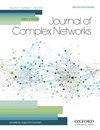Community detection and reciprocity in networks by jointly modelling pairs of edges
IF 1.5
4区 数学
Q2 MATHEMATICS, INTERDISCIPLINARY APPLICATIONS
引用次数: 11
Abstract
To unravel the driving patterns of networks, the most popular models rely on community detection algorithms. However, these approaches are generally unable to reproduce the structural features of the network. Therefore, attempts are always made to develop models that incorporate these network properties beside the community structure. In this article, we present a probabilistic generative model and an efficient algorithm to both perform community detection and capture reciprocity in networks. Our approach jointly models pairs of edges with exact two-edge joint distributions. In addition, it provides closed-form analytical expressions for both marginal and conditional distributions. We validate our model on synthetic data in recovering communities, edge prediction tasks and generating synthetic networks that replicate the reciprocity values observed in real networks. We also highlight these findings on two real datasets that are relevant for social scientists and behavioural ecologists. Our method overcomes the limitations of both standard algorithms and recent models that incorporate reciprocity through a pseudo-likelihood approximation. The inference of the model parameters is implemented by the efficient and scalable expectation–maximization algorithm, as it exploits the sparsity of the dataset. We provide an open-source implementation of the code online.基于边对联合建模的网络社区检测与互易性研究
为了解开网络的驱动模式,最流行的模型依赖于社区检测算法。然而,这些方法通常无法再现网络的结构特征。因此,人们总是试图开发在社区结构之外包含这些网络属性的模型。在本文中,我们提出了一个概率生成模型和一个有效的算法来执行网络中的社区检测和捕获互易性。我们的方法联合建模具有精确两个边联合分布的边对。此外,它还为边际分布和条件分布提供了闭合形式的分析表达式。我们在恢复社区、边缘预测任务和生成复制真实网络中观察到的互易值的合成网络的合成数据上验证了我们的模型。我们还在两个与社会科学家和行为生态学家相关的真实数据集上强调了这些发现。我们的方法克服了标准算法和最近通过伪似然近似结合互易性的模型的局限性。模型参数的推断是通过高效且可扩展的期望最大化算法实现的,因为它利用了数据集的稀疏性。我们在线提供代码的开源实现。
本文章由计算机程序翻译,如有差异,请以英文原文为准。
求助全文
约1分钟内获得全文
求助全文
来源期刊

Journal of complex networks
MATHEMATICS, INTERDISCIPLINARY APPLICATIONS-
CiteScore
4.20
自引率
9.50%
发文量
40
期刊介绍:
Journal of Complex Networks publishes original articles and reviews with a significant contribution to the analysis and understanding of complex networks and its applications in diverse fields. Complex networks are loosely defined as networks with nontrivial topology and dynamics, which appear as the skeletons of complex systems in the real-world. The journal covers everything from the basic mathematical, physical and computational principles needed for studying complex networks to their applications leading to predictive models in molecular, biological, ecological, informational, engineering, social, technological and other systems. It includes, but is not limited to, the following topics: - Mathematical and numerical analysis of networks - Network theory and computer sciences - Structural analysis of networks - Dynamics on networks - Physical models on networks - Networks and epidemiology - Social, socio-economic and political networks - Ecological networks - Technological and infrastructural networks - Brain and tissue networks - Biological and molecular networks - Spatial networks - Techno-social networks i.e. online social networks, social networking sites, social media - Other applications of networks - Evolving networks - Multilayer networks - Game theory on networks - Biomedicine related networks - Animal social networks - Climate networks - Cognitive, language and informational network
 求助内容:
求助内容: 应助结果提醒方式:
应助结果提醒方式:


